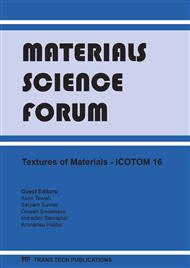p.574
p.578
p.585
p.591
p.595
p.599
p.603
p.607
p.611
Texture and Microstructure Evolution during Box Annealing of a Non-Oriented-Grain Electrical Steel
Abstract:
Non-oriented grain type electrical steels are used mainly in electrical rotating machines such as motors and compressors, in which the magnetization direction rotates 360 ° every cycle while remaining in the plane of the plate. The performance of these devices is affected by crystallographic texture of electrical steels due to strong anisotropy of magnetic properties. The electrical steel is supplied in the form of plates which are processed by cold rolling and subsequent annealing. Both, cold rolling and annealing directly influence the formation of crystallographic texture components. During annealing, recrystallization occurs, and this phenomenon gives rise to changes in texture that influences the quality of the final product and its application. Several works have been published in the study of the evolution of crystallographic texture and grain size in this type of electrical steel. In this work, samples have been taken in industrial conditions at various temperatures during the annealing in a coil box. Electrical steel samples cold rolled with reductions of 50% and 70% in thickness were removed during the process of annealing, and the evolution of texture with increasing temperature was studied. Aspects related to recrystallization, grain size and the evolution of texture and magnetic properties were discussed. Texture and recrystallization were studied by X-ray diffraction and electron backscatter diffraction (EBSD). The magnetic properties were measured in a vibrating sample magnetometer.
Info:
Periodical:
Pages:
595-598
Citation:
Online since:
December 2011
Keywords:
Price:
Сopyright:
© 2012 Trans Tech Publications Ltd. All Rights Reserved
Share:
Citation:


